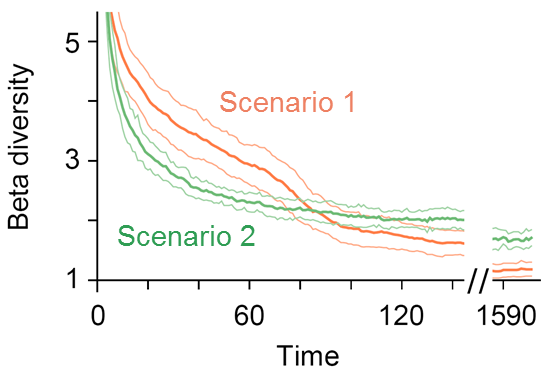Transient states
The concept of alternative stable states has long been the dominant framework for studying historical contingency in community assembly. According to this concept, a community can approach one of a set of possible stable states of species composition, depending on assembly history, and once a community assumes a stable state, it cannot move to another unless heavily disturbed. Theoretically, this concept makes sense, but many actual communities are in a transient, not stable, state, even long after the last major disturbance event.
 Using a simulation model of plant community assembly, we have shown that the conditions under which community structure is historically contingent can differ greatly between stable and transient states (Fukami and Nakajima 2011). This work suggests that a conceptual shift of focus from stable to transient states is needed to understand community assembly. We are studying transient states further, focusing on plant-soil feedbacks as a mechanism of priority effects. We have proposed a new idea, called the delayed convergence hypothesis, which predicts that complex plant-soil feedbacks lengthen the period of species turnover that local plant communities undergo after disturbance events (Fukami and Nakajima 2013). During this turnover, species composition is affected by stochastic variation in immigration history. As a consequence, these transient communities collectively enhance regional species diversity, even if these communities would converge to a single state given enough time. We are working to develop this hypothesis further to gain a better understanding of the regional maintenance of species diversity (Fukami et al. 2017).
Using a simulation model of plant community assembly, we have shown that the conditions under which community structure is historically contingent can differ greatly between stable and transient states (Fukami and Nakajima 2011). This work suggests that a conceptual shift of focus from stable to transient states is needed to understand community assembly. We are studying transient states further, focusing on plant-soil feedbacks as a mechanism of priority effects. We have proposed a new idea, called the delayed convergence hypothesis, which predicts that complex plant-soil feedbacks lengthen the period of species turnover that local plant communities undergo after disturbance events (Fukami and Nakajima 2013). During this turnover, species composition is affected by stochastic variation in immigration history. As a consequence, these transient communities collectively enhance regional species diversity, even if these communities would converge to a single state given enough time. We are working to develop this hypothesis further to gain a better understanding of the regional maintenance of species diversity (Fukami et al. 2017).